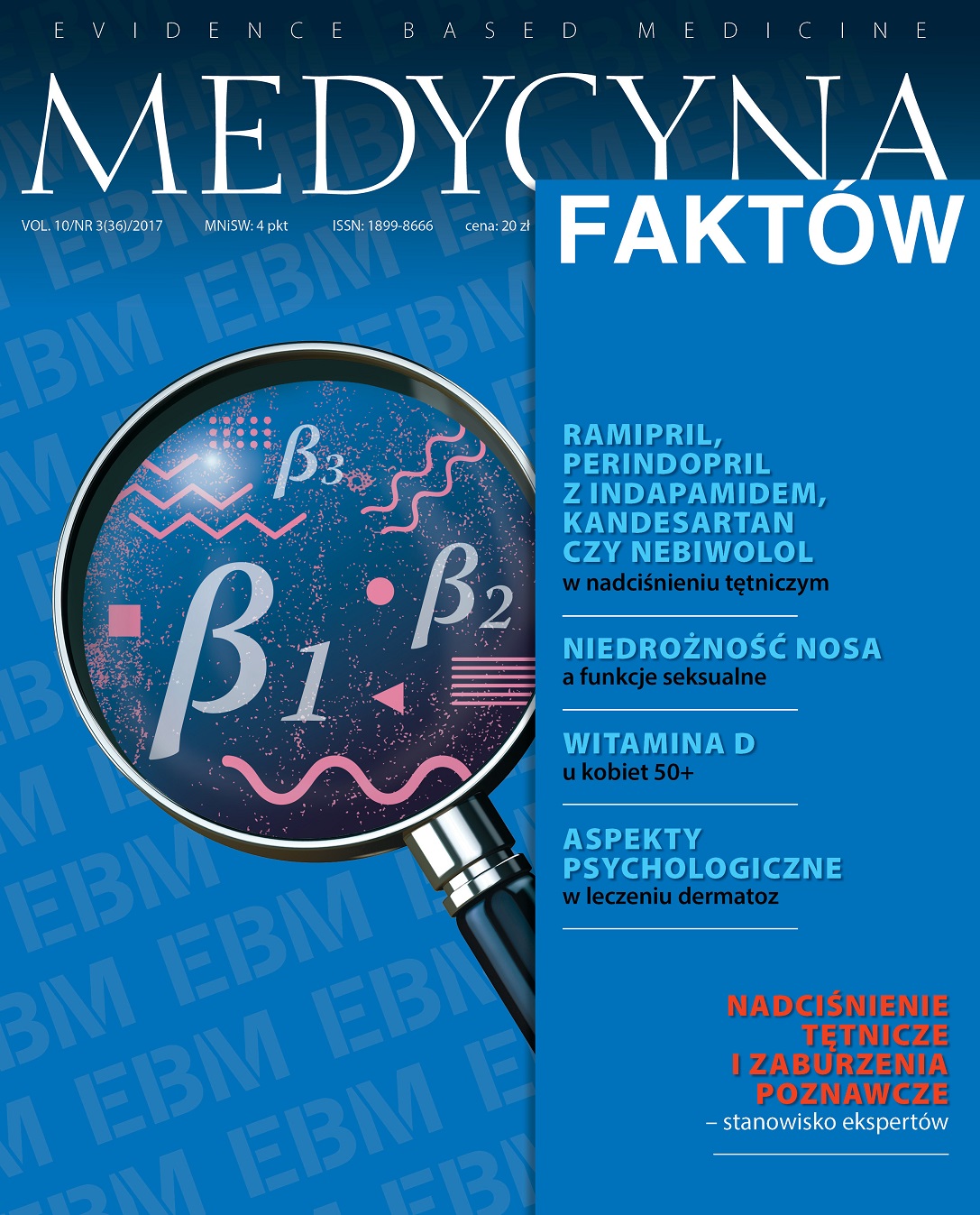Why vitamin D supplementation is necessary in women 50+? Review article
Main Article Content
Abstract
Recent studies have demonstrated the involvement of vitamin D not only in bone metabolism, but also in immunological processes. Vitamin D supplementation in women over the age of 50 is associated with a decrease in the risk of osteoporosis fractures and falls as well as with an increase in muscular strength. Studies indicate that vitamin D deficiency is linked to increased incidence of autoimmunological diseases, and vitamin D supplementation reduces the incidence of rheumatoid arthritis. In the 50+ female patients vitamin D should be supplemented all year round.
Article Details
How to Cite
Sapilak , B. J., Tłustochowicz , W., & Braszkiewicz, M. (2017). Why vitamin D supplementation is necessary in women 50+?. Medycyna Faktow (J EBM), 10(3(36), 241-244. Retrieved from https://journalsmededu.pl/index.php/jebm/article/view/2132
Issue
Section
Articles
Copyright © by Medical Education. All rights reserved.
References
1. Karczmarewicz E., Czekuć-Kryśkiewicz E., Płudowski P.: Effect of vitamin D status on pharmacological treatment efficiency – impact on cost-effective management in medicine. Dermatoendocrinology 2013; 5: 299-304.
2. Płudowski P., Karczmarewicz E., Chlebna-Sokół D. et al.: Witamina D: Rekomendacje dawkowania w populacji osób zdrowych oraz w grupach ryzyka deficytów – wytyczne dla Europy Środkowej 2013 r. Standardy Medyczne/Pediatria 2013; 10: 573-578.
3. Myszka M., Klinger M.: Immunomodulacyjne działanie witaminy D. Postępy Hig. Med. Dośw. 2014; 68: 865-878.
4. Bischoff H.A., Stahelin H.B., Dick W. et al.: Effects of vitamin D and calcium supplementation on falls: a randomized controlled trial. J. Bone Miner. Res. 2003; 18: 343-351.
5. Wacker M., Holick M.: Vitamin D – effects on skeletal and extraskeletal health and the need for supplementation. Nutrients 2013; 5: 111-148.
6. Pelajo C.F., Lopez-Benitez J.M., Miller L.C.: Vitamin D and autoimmune rheumatic disorders. Autoimmun. Rev. 2010; 9: 507-510.
7. Ponsonby A.L., McMichael A., van der Mei I.: Ultraviolet radiation and autoimmune disease: insights from epidemiological research. Toxicology 2002; 181-182: 71-78.
8. DeLuca H.F.: Overview of general physiologic features and functions of vitamin D. Am. J. Clin. Nutr. 2004; 80: 1689S-1696S.
9. Norman A.W.: Minireview: vitamin D receptor: new assignments for an already busy receptor. Endocrinology 2006; 147: 5542-5548.
10. Pierrot-Deseilligny C., Rivaud-Pechoux S., Clerson P. et al.: Relationship between 25-OH-D serum level and relapse rate in multiple sclerosis patients before and after vitamin D supplementation. Ther. Adv. Neurol. Disord. 2012; 5: 187-198.
11. Merlino L.A., Curtis J., Mikuls T.R. et al.: Vitamin D intake is inversely associated with rheumatoid arthritis: results from the Iowa Women’s Health Study. Arthritis Rheum. 2004; 50: 72-77.
12. Bischoff-Ferrari H.A., Willett W.C., Orav E.J. et al.: A pooled analysis of vitamin D requirements for fracture prevention. N. Engl. J. Med. 2012; 367: 40-49.
13. Gallagher J.Ch., Sri Harsha T.: Prevention and treatment of postmenopausal osteoporosis. J. Steroid Biochem. Mol. Biol. 2014; 142: 155-170.
14. Al. Mheid I., Quyyumi A.A.: Vitamin D and Cardiovascular Disease. J. Am. Coll. Cardiol. 2017; 70: 89-100.
15. Lerchbaum E.: Vitamin D and menopause – A narrative review. Maturitas 2014; 79(1): 3-7.
16. Witamina D: Rekomendacje dawkowania w populacji osób zdrowych oraz w grupach ryzyka deficytów – wytyczne dla Europy Środkowej 2013 r. Standardy Medyczne/Pediatria 2013; 10: 573-578.
2. Płudowski P., Karczmarewicz E., Chlebna-Sokół D. et al.: Witamina D: Rekomendacje dawkowania w populacji osób zdrowych oraz w grupach ryzyka deficytów – wytyczne dla Europy Środkowej 2013 r. Standardy Medyczne/Pediatria 2013; 10: 573-578.
3. Myszka M., Klinger M.: Immunomodulacyjne działanie witaminy D. Postępy Hig. Med. Dośw. 2014; 68: 865-878.
4. Bischoff H.A., Stahelin H.B., Dick W. et al.: Effects of vitamin D and calcium supplementation on falls: a randomized controlled trial. J. Bone Miner. Res. 2003; 18: 343-351.
5. Wacker M., Holick M.: Vitamin D – effects on skeletal and extraskeletal health and the need for supplementation. Nutrients 2013; 5: 111-148.
6. Pelajo C.F., Lopez-Benitez J.M., Miller L.C.: Vitamin D and autoimmune rheumatic disorders. Autoimmun. Rev. 2010; 9: 507-510.
7. Ponsonby A.L., McMichael A., van der Mei I.: Ultraviolet radiation and autoimmune disease: insights from epidemiological research. Toxicology 2002; 181-182: 71-78.
8. DeLuca H.F.: Overview of general physiologic features and functions of vitamin D. Am. J. Clin. Nutr. 2004; 80: 1689S-1696S.
9. Norman A.W.: Minireview: vitamin D receptor: new assignments for an already busy receptor. Endocrinology 2006; 147: 5542-5548.
10. Pierrot-Deseilligny C., Rivaud-Pechoux S., Clerson P. et al.: Relationship between 25-OH-D serum level and relapse rate in multiple sclerosis patients before and after vitamin D supplementation. Ther. Adv. Neurol. Disord. 2012; 5: 187-198.
11. Merlino L.A., Curtis J., Mikuls T.R. et al.: Vitamin D intake is inversely associated with rheumatoid arthritis: results from the Iowa Women’s Health Study. Arthritis Rheum. 2004; 50: 72-77.
12. Bischoff-Ferrari H.A., Willett W.C., Orav E.J. et al.: A pooled analysis of vitamin D requirements for fracture prevention. N. Engl. J. Med. 2012; 367: 40-49.
13. Gallagher J.Ch., Sri Harsha T.: Prevention and treatment of postmenopausal osteoporosis. J. Steroid Biochem. Mol. Biol. 2014; 142: 155-170.
14. Al. Mheid I., Quyyumi A.A.: Vitamin D and Cardiovascular Disease. J. Am. Coll. Cardiol. 2017; 70: 89-100.
15. Lerchbaum E.: Vitamin D and menopause – A narrative review. Maturitas 2014; 79(1): 3-7.
16. Witamina D: Rekomendacje dawkowania w populacji osób zdrowych oraz w grupach ryzyka deficytów – wytyczne dla Europy Środkowej 2013 r. Standardy Medyczne/Pediatria 2013; 10: 573-578.

